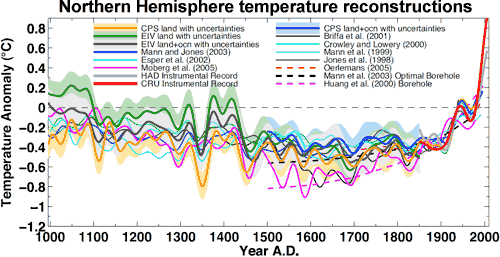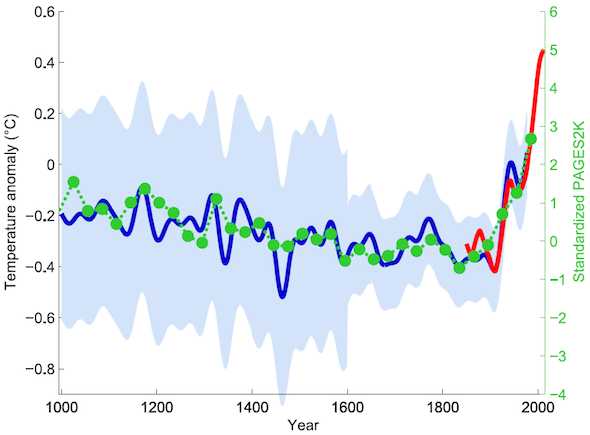GLG
Well-Known Member
Because once again you are wrong.
The albedo of Earth
by Judith Curry
An important new paper finds that the albedo of Earth is highly regulated, mostly by clouds, with some surprising consequences.
The albedo of Earth
Graeme L. Stephens, Denis O’Brien, Peter J. Webster, Peter Pilewski, Seiji Kato, and Jui-lin Li
Abstract. The fraction of the incoming solar energy scattered by Earth back to space is referred to as the planetary albedo. This reflected energy is a fundamental component of the Earth’s energy balance, and the processes that govern its magnitude, distribution, and variability shape Earth’s climate and climate change. We review our understanding of Earth’s albedo as it has progressed to the current time and provide a global perspective of our understanding of the processes that define it. Joint analyses of surface solar flux data that are a complicated mix of measurements and model calculations with top-of-atmosphere (TOA) flux measurements from current orbiting satellites yield a number of surprising results including (i) the Northern and Southern Hemispheres (NH, SH) reflect the same amount of sunlight within ~ 0.2Wm2. This symmetry is achieved by increased reflection from SH clouds offsetting precisely the greater reflection from the NH land masses. (ii) The albedo of Earth appears to be highly buffered on hemispheric and global scales as highlighted by both the hemispheric symmetry and a remarkably small interannual variability of reflected solar flux (~0.2% of the annual mean flux). We show how clouds provide the necessary degrees of freedom to modulate the Earth’s albedo setting the hemispheric symmetry. We also show that current climate models lack this same degree of hemispheric symmetry and regulation by clouds. The relevance of this hemispheric symmetry to the heat transport across the equator is discussed.
Published in Reviews of Geophysics; [link] to full manuscript.
Excerpts from the Introduction:
There are many reasons why it is important to understand the variability of the Earth’s albedo and the factors that define it:
1. Simple energy balance models of the climate system are unstable to small changes in the amount of energy reflected to space. In these simple models with an albedo overly sensitive to surface temperature, relatively small changes in the absorbed solar energy can swing these models from a near ice-free Earth to a fully ice covered state.
2. It is also speculated that albedo changes potentially regulate the climate system. Lovelock’s Gaia hypothesis, exemplified in the study of “Daisyworld”, suggests that regulation of the system albedo by the adaptation of biota of differing albedos to climate change might in fact buffer the system from the instabilities inherent to earlier energy balance models.
3. The reflection of sunlight by clouds provides an important climate change feedback mechanism. Our inability to quantify these feedbacks with any certainty is recognized as one of the major obstacles in climate change predictions .
4. More locally, the Earths albedo appears to be resilient to other internal changes that might otherwise alter the system albedo. Perturbations to the albedo through effects of aerosol on clouds appears to be buffered by compensating processes that restrict local albedo changes to changing aerosol influences. The implications of these more local compensations to concepts proposed to mitigate climate change through geoengineering cloud albedo are thus profound.
5. Regulation of the Earth’s albedo is also central to other important climate feedbacks, including the snow/ice surface albedo feedback as well as cloud feedbacks.
6. It has also been conjectured that the characteristics of the total energy transport from low to high latitudes are insensitive to the structure and dynamics of the atmosphere-ocean system and are determined primarily by external controls such as the solar constant, the size of the Earth, the tilt of the Earth’s axis, and the hemispheric mean albedo.
We show, as in other studies, that the Northern and Southern Hemispheres (NH and SH) reflect the same amount of sunlight within 0.2Wm2. We show clearly how this is achieved as a consequence of reflection from increased amounts of SH clouds offsetting precisely the increased reflection from the larger NH land masses . The spectral distribution of this reflected energy exhibits clear differences between the hemispheres that reinforce our understanding of how the hemispheric symmetry is established.
The albedo appears to be highly constrained on the hemispheric and global scale and over interannual timescales. The hemispheric symmetry is an example of such a constraint, and the interannual variability of reflected energy is another example. The interannual variability is small, mostly regulated by the changes to clouds associated with the main modes of climate variability. Overall, these changes occur in a way that minimizes the global effects of clouds on the albedo, buffering the Earth system from large changes.
We also show that the ability of present-day models of climate in simulating the statistical properties of the energy reflected from Earth varies depending upon the metric used. Models produce a much more variable reflected sunlight than observed and fail to reproduce the same degree of hemispheric symmetry. Simple arguments suggest that a symmetric energy balance implies zero net cross equatorial transport of heat that is also a condition of a steady state. Although Earth is very near this symmetric state, it is out of energy balance, with less outgoing longwave radiative (OLR) emitted from the SH than the NH. This hemispheric asymmetry in OLR contributes to the approximate 0.6Wm2 imbalance observed and is associated with offsetting transports of heat from north to south in the atmosphere and from south to north in the oceans.
From the section Discussion:
Is the Hemispheric Symmetry Purely Coincidental? While Voigt et al. could not rule out the possibility of the observed hemispheric symmetry being merely accidental, their results suggest that mechanisms exist to minimize hemispheric differences in reflected shortwave irradiance and planetary albedo in some fundamental way. Voigt et al. searched for possible mechanisms in simple aqua-planet simulations using a general circulation model coupled to a slab ocean. The experiments were performed with the model initialized with an imposed hemispheric difference in clear-sky albedo. The results showed how the Intertropical Convergence Zone (ITCZ) adapted in such a way as to compensate for the imposed hemispheric asymmetries in clear-sky albedo. The compensation occurred as a shift of the ITCZ and tropical clouds into the darker hemisphere, suggesting that in these model simulations the climate system prefers hemispheric albedo asymmetries to be small and that cloudiness serves as a strong regulator of albedo. The main point of these studies is they show how adjustments of cloud patterns in one hemisphere can influence the properties of the other hemisphere, thus hinting at possible mechanisms that determine how a symmetric energy balance might be maintained.
From the Summary:
We also show, as others before, how the amount of solar energy reflected from each hemisphere is essentially identical. This symmetry appears in broadband data but not in spectral radiances, thus hinting at the importance of such spectral data as a diagnostic tool for studying Earth’s climate system. Again, the cloudiness of the planet is the principal regulatory agent that maintains this symmetry with the increased energy reflected from SH clouds precisely balancing the larger reflections from NH land masses. Simple arguments suggest that a symmetric energy balance implies zero cross equatorial transport of heat, which is a condition of a steady state. Although Earth is very near this symmetric state, it is currently out of energy balance with less OLR emitted from the SH than the NH giving rise to the approximate 0.6Wm2 global imbalance observed.
Climate models fail to reproduce the observed annual cycle in all components of the albedo with any realism, although they broadly capture the correct proportions of surface and atmospheric contributions to the TOA albedo. A high model bias of albedo has also persisted since the time of CMIP3,mostly during the boreal summer season. Perhaps more importantly, models fail to produce the same degree of interannual constraint on the albedo variability nor do they reproduce the same degree of hemispheric symmetry. The significance of these shortcomings is not yet fully known, but model studies of hypothetical slab-ocean worlds suggest that interhemispheric changes in albedo can grossly affect the climate states of those worlds, shifting the ITCZ and altering the amount of heat moved poleward.
JC reflections
The implications of this paper strike me as profound. Planetary albedo is a fundamental element of the Earth’s climate. This paper implies the presence of a stabilizing feedback between atmosphere/ocean circulations, clouds and radiation. Climate models do not capture this stabilizing feedback.
The results of this paper also have interesting implications for ice ages, whereby the forcing that is predominant in one hemisphere is felt in the other.
The failure of models to reproduce this hemisphere synchronicity raises interesting implications regarding the fidelity of climate model-derived sensitivity to CO2.
Moderation note: this is a technical thread, please keep your comments relevant.
OBD you should read this as it does have many valid points.....
Why don't you study this albedo effect and really learn something. Its important to understand.








